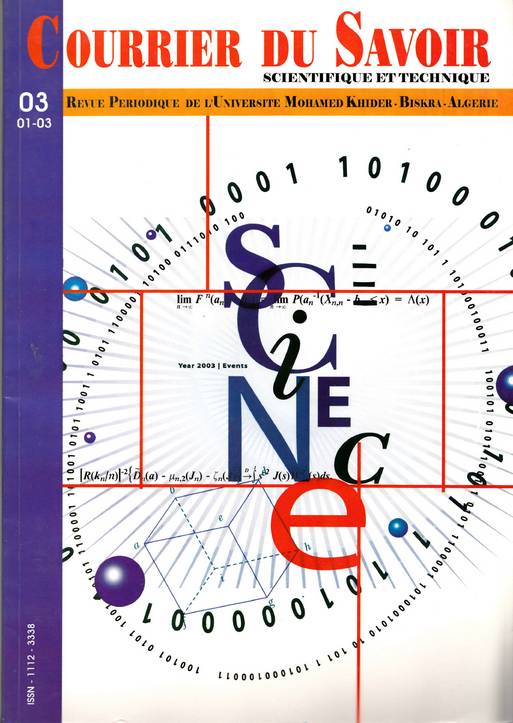PROPRIETES STRUCTURALES DE COPOLYMERES BISEQUENCE ET TRISEQUENCE LINEAIRES ET DE LEUR HOMOLOGUE CYCLIQUE EN SOLUTION DILUEE STRUCTURAL PROPERTIES OF LINEAR DIBLOCK AND TRIBLOCK COPOLYMERS AND THEIR CYCLIC HOMOLOGOUS IN DILUTE SOLUTION
Résumé
SUMMARY
The structural properties of linear block copolymers in solution aroused a considerable interest and are the subject of many
theoretical and experimental investigations. However, their cyclic counterparts received only a limited attention from
researchers mainly because of difficulties related to their synthesis with high-molecular weights and a low polydispersity. This
study was justified by the relatively recent light scattering measurements carried out by Amis et al. on a cyclic diblock
copolymer and its linear triblock counterpart made up of polystyrene (PS) and poly(dimethylsiloxane) (PDMS). In this work,
the adopted theoretical approach is based on the random phase approximation when the polymeric systems under study are
placed in similar conditions of temperature, concentration, composition and mass than those covered experimentally by Amis
and others. The main objective of this study is intended to present a theoretical formalism allowing a systematic analysis of the
scattering data, relating to block copolymers of arbitrary architectures, and to suggest some indications relating to their
treatment. In terms of thermodynamic and structural properties, the results obtained reveal differences between the two types
of copolymers. In particular, contrary to what was brought back by Amis and his collaborators, the discrepancies, shown
between the radii of gyration of linear block copolymers and their cyclic counterpart, being sufficiently large, it should be
possible to highlight them in experiments by light scattering.
RESUME
Les propriétés structurales de copolymères séquencés linéaires en solution ont suscité un intérêt considérable et fait l'objet de
nombreuses investigations théoriques et expérimentales. Cependant, leurs homologues cycliques n'ont retenu l'attention que
d'un nombre limité de chercheurs principalement du fait de difficultés liées à leur synthèse avec des poids moléculaires élevés
et une faible polydispersité. Cette étude a été motivée par des mesures de diffusion de lumière relativement récentes réalisées
par Amis et al. sur un copolymère biséquencé cyclique et son homologue triséquencé linéaire constitué de polystyrène (PS) et
de poly(diméthylsiloxane) (PDMS). Dans ce travail, l'approche théorique adoptée est basée sur l'approximation de la phase
aléatoire en plaçant les systèmes polymériques considérés dans des conditions de température, de concentration, de
composition et de masse similaires à celles couvertes expérimentalement par Amis et autres. L’objectif premier de la présente
étude consiste à présenter un formalisme théorique permettant une analyse systématique de données de diffusion, relatives à
des copolymères séquencés d'architectures arbitraires, et de suggérer quelques indications concernant le traitement de celles-ci.
En termes de propriétés thermodynamiques et structurales, les résultats obtenus révèlent des écarts entre les deux types de
copolymères. En particulier, contrairement à ce qui a été rapporté par Amis et ses collaborateurs, les différences, relevées entre
les rayons de giration de copolymères séquencés linéaires et de leur homologue cyclique, étant suffisamment importantes, il
devrait être possible de les mettre en évidence expérimentalement par diffusion de lumière.
Références
[2] de Gennes, P. G. Scaling Concepts in Polymer
Physics; Cornell University Press: Ithaca, N. Y, 1979;
J. Phys. (Paris) 1970, 31, 235.
[3] Balsara, N. P.; Stepanek, P.; Lodge, T. P.; Tirrell, M.
Macromolecules 1991, 24, 6227.
[4] Borsali, R.; Benoît, H.; Legrand, J. F.; Duval, M.;
Picot, C.; Benmouna, M.; Farago, B. Macromolecules
1989, 22, 4119.
[5] Benmouna, M.; Benoît, H.; Borsali, R.; Duval, M.
Macromolecules 1987, 20, 2620.
[6] Hammouda, B. Adv. Polym. Sci. 1993, 106, 87.
[7] Duval, M.; Picot, C.; Benmouna, M.; Benoît, H. J.
Phys. France 1988, 49, 1963.
[8] Akcasu, Z. Dynamic Light Scattering, Wyn Brown
(ed.), Oxford University Press, Oxford, 1994.
[9] Ionesco, I.; Picot, C.; Dupplexis, R.; Duval, M.;
Benoît, H.; Lingelser, J. P.; Gallot, Y. J. Polym. Sci.,
Polym. Phys. Ed. 1981, 19, 1033.
[10] Amis, E. J.; Hodgson, D. F. Polym. Prep. 1991, 32,
617.
[11] Amis, E. J.; Hodgson, D. F.; Wu, W. J. Polym. Sci.,
Part B: Polym. Phys. 1993, 31, 2049.
[12] Benmouna, M.; Borsali, R.; Benoît, H. J. Phys. II,
France 1993, 3, 1041.
[13] Rabin, I.; Marko, J. F. Macromolecules 1992, 25, 1503.
[14] Weil, R.; Vinograd, J. Proc. Natl. Acad. Sci. (U.S.A)
1963, 50, 730.
[15] Candau, F.; Rempp, P.; Benoît, H. Macromolecules
1972, 5, 627.
[16] Hadziioannou, G.; Cotts, P. M.; ten Brinke, G.; Han, C.
C.; Lutz, P.; Strazielle, C.; Rempp, P.; Kovacs, A. J.
Macromolecules 1987, 20, 493.
[17] Burchard, W. Cyclic Polymers, Chapter 2, Semlyen, J.
A. Editor, Elsevier, London, 1986.
[18] Higgins, J. S.; Dodgson, K.; Semlyen, J. A. Polymer
1979, 20, 553.
[19] Edwards, C. J.C.; Stepto, R. F. T. Cyclic Polymers,
Chapter 4, Semlyen, J. A (Editor), Elsevier, London,
1986.
[20] McKenna, G. B.; Hadziioannou, G.; Lutz, P.; Hild, G.;
Strazielle, C.; Straupe, C.; Rempp, P.; Kovacs, A. J.
Macromolecules 1987, 20, 498.
[21] Yin, R.; Hogen-Esch, T. E. Polym. Prep. 1992, 33,
239.
[22] Strazielle, C.; Benoît, H. Macromolecules 1975, 8, 203.
[23] 23. Higgins, J. S.; Benoît, H. Polymers and Neutron
Scattering, Clarendon Press, Oxford, 1994.
[24] Flory, P. J. Principles of Polymer Chemistry, Cornell
University Press, Ithaca, 1953.
[25] Abramowitz, M.; Stegun, I. A. Handbook of
Mathematical Functions, AMS 555, NBS. Also,
Gradshteyn, I. S. and Ryzhik, I. W. Tables of Integrals,
Series and Products, Academic Press, New York, 1965.
[26] Casassa, E. F. J. Polym. Sci. Part A 1965, 3, 605.


